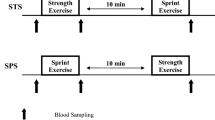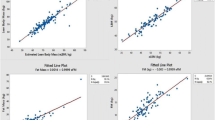Abstract
The hormonal responses of nine male, strength athletes to strength exercise were examined. The athletes performed one moderate- and one high-intensity strength exercise workout. In the high-intensity workout, the load was 100% of each subject's three-repetition maximum (3-RM) for squats and front squats, and 100% of each subject's six-repetition maximum (6-RM) for leg extensions. In the moderate-intensity workout, the load was 70% of the high-intensity protocol. Rest periods between sets were 4–6 min for both workouts. Blood samples were taken before, 30 min into, and every 15 min for the 1st h after exercise, and then 3, 7, 11, 22 and 33 h after exercise, thus allowing examination of both the acute and prolonged hormonal responses. Blood samples were analyzed for testosterone, luteinizing hormone (LH), follicle stimulating hormone (FSH), cortisol, adrenocorticotrophic hormone (ACTH), growth hormone (GH), insulin-like growth factor (IGF-1), insulin, sex hormone binding globulin, creatine kinase, total protein, glucose and lactate. The acute responses of testosterone and cortisol were greater during the high-intensity protocol as compared to the moderate-intensity protocol. The cortisol response was associated with an increase in ACTH concentration. LH and FSH showed no response to either protocol. Acute GH responses were not different between protocols. There were great inter-individual differences in acute GH responses to both protocols. There were no significant differences between protocols with regard to prolonged responses for any hormone. In both trials, IGF-1 concentrations were significantly lower at 0800 hours the morning after exercise as compared to concentrations found at 0800 hours the morning before exercise. The mechanisms responsible for reducing IGF-1 concentration in these trials are unclear, and it is not known if this reduction observed 22 hours after exercise is of physiological significance.
Similar content being viewed by others
Author information
Authors and Affiliations
Additional information
Accepted: 13 December 1999
Rights and permissions
About this article
Cite this article
Raastad, T., Bjøro, T. & Hallén, J. Hormonal responses to high- and moderate-intensity strength exercise. Eur J Appl Physiol 82, 121–128 (2000). https://doi.org/10.1007/s004210050661
Issue Date:
DOI: https://doi.org/10.1007/s004210050661




